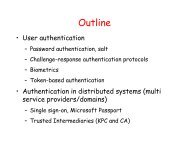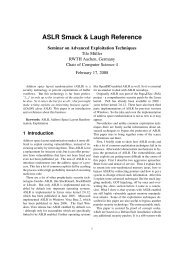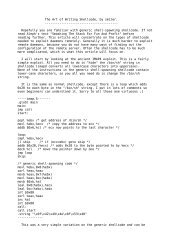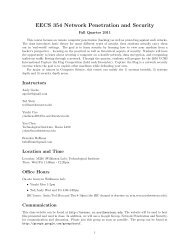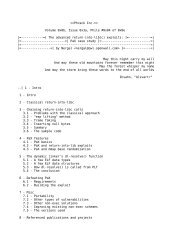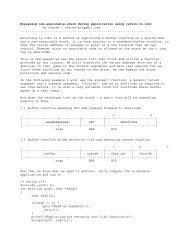Fixing Races for Fun and Profit: How to abuse atime - University of ...
Fixing Races for Fun and Profit: How to abuse atime - University of ...
Fixing Races for Fun and Profit: How to abuse atime - University of ...
Create successful ePaper yourself
Turn your PDF publications into a flip-book with our unique Google optimized e-Paper software.
OS Filesystem MAXPATHLEN Link limit Dir. Size Max. Maze Max. Maze<br />
(KB) Length Size (MB)<br />
Linux 2.6.8 ext3 4096 40 4 81920 327<br />
Solaris 9 ufs 1024 20 0.5 10240 5<br />
FreeBSD 4.10-PR2 ufs 1024 32 0.5 16384 8<br />
Table 2: MAXPATHLEN, the symbolic link limit, <strong>and</strong> other relevant parameters <strong>for</strong> three common Unix variants. Notice<br />
that on Linux a single filename lookup can require traversing over 300MB <strong>of</strong> on-disk data.<br />
rec<strong>to</strong>ries every time it calls access(2) or open(2). The<br />
attacker is very likely <strong>to</strong> win the race if even just one <strong>of</strong><br />
these direc<strong>to</strong>ries is not in the filesystem buffer cache.<br />
Table 2 also shows the on-disk size <strong>of</strong> the largest maze<br />
possible on each system. This figure gives us some insight<br />
in<strong>to</strong> why this attack is so successful. For example,<br />
under Linux 2.6, an attacker can construct a filename that<br />
requires loading over 300MB <strong>of</strong> data from disk, just <strong>to</strong><br />
resolve it. It is not surprising that when the victim calls<br />
access(2) or open(2) on such a filename it is extremely<br />
likely <strong>to</strong> sleep on I/O, giving the attacker plenty <strong>of</strong> time<br />
<strong>to</strong> execute her attack.<br />
Probabilistic cache flushing. Mazes are so powerful<br />
that the attacker does not need <strong>to</strong> flush all the attack direc<strong>to</strong>ries<br />
from cache. Instead, she can simply do “best<br />
ef<strong>for</strong>t” flushing by engaging in filesystem activity <strong>of</strong> her<br />
own. This activity will cause the buffer cache <strong>to</strong> flush<br />
old items <strong>to</strong> make space <strong>for</strong> the new ones. For example,<br />
running the comm<strong>and</strong> grep -r any string /usr<br />
> /dev/null 2>&1 4 populates the buffer cache with<br />
new items <strong>and</strong> will <strong>of</strong>ten flush some <strong>of</strong> the attack direc<strong>to</strong>ries<br />
from the cache. With large mazes, the recursive<br />
grep is very likely <strong>to</strong> flush at least one <strong>of</strong> the direc<strong>to</strong>ries<br />
in each maze, enabling the attacker <strong>to</strong> successfully break<br />
the k-Race algorithm.<br />
Summary. To defeat k-Race using k strengthening<br />
rounds, the attacker creates M = 2k + 2 direc<strong>to</strong>ries,<br />
maze0, . . ., maze2k + 1, builds a maze in each <strong>of</strong> these<br />
direc<strong>to</strong>ries, <strong>and</strong> sets the symlink activemaze <strong>to</strong> initially<br />
point <strong>to</strong> maze0, as shown in Figure 8. The exit<br />
links in the even-numbered mazes point <strong>to</strong> an attacker<br />
accessible file, <strong>and</strong> the exit links in the odd-numbered<br />
mazes point <strong>to</strong> the protected file under attack. After creating<br />
this direc<strong>to</strong>ry setup, the attacker uses grep or some<br />
other common Unix <strong>to</strong>ol <strong>to</strong> flush some <strong>of</strong> the direc<strong>to</strong>ries<br />
in the mazes out <strong>of</strong> cache. She then executes the victim<br />
with the path activemaze/sentry/lnk/.../<br />
lnk <strong>and</strong> advances activemaze <strong>to</strong> point <strong>to</strong> the next<br />
4 We have found this method more reliable if the grep comm<strong>and</strong><br />
searches the files on the same disk as the mazes. This is likely <strong>to</strong> be a<br />
consequence <strong>of</strong> on-disk caching.<br />
activemaze<br />
relative link<br />
Maze 0<br />
Maze 1<br />
Maze 2<br />
Maze 3<br />
Maze 4<br />
relative link from exit <strong>to</strong> public file<br />
relative link from exit <strong>to</strong> secret file<br />
relative link from exit <strong>to</strong> public file<br />
relative link from exit <strong>to</strong> secret file<br />
relative link from exit <strong>to</strong> public file<br />
Figure 8: Malicious direc<strong>to</strong>ry structure <strong>to</strong> attack the k-<br />
Race defense using the maze structure from Figure 6.<br />
This construction is particularly effective when k is large.<br />
maze direc<strong>to</strong>ry whenever she detects that the access time<br />
<strong>of</strong> activemaze/sentry has changed.<br />
Experimental results. We implemented the k-Race algorithm,<br />
including r<strong>and</strong>omized delays between every<br />
system call <strong>and</strong> between each round <strong>of</strong> strengthening.<br />
We did not implement the extended k-Race defenses,<br />
such as setting the victim scheduling priority <strong>to</strong> FIFO<br />
or using mlock() <strong>to</strong> pin its pages in memory. We do<br />
not believe these enhancements would prevent our attack<br />
from succeeding.<br />
We implemented <strong>and</strong> tested the attack on three Unix<br />
variants: Linux 2.6.8, Solaris 9, <strong>and</strong> FreeBSD 4.10-PR2.<br />
The Linux machine contains a 1.3GHz AMD Athlon processor,<br />
1GB <strong>of</strong> RAM,<strong>and</strong> a 160GB, 7200RPM IDE disk<br />
with an 8MB on-disk cache <strong>and</strong> 9ms average seek time.<br />
The FreeBSD machine contains a 1.4GHz Pentium IV,<br />
512MB <strong>of</strong> RAM, <strong>and</strong> a 40GB, 7200RPM IDE disk with<br />
a 2MB on-disk cache <strong>and</strong> 8.5ms average seek time. The<br />
Solaris machine is a multiprocessor with two 450MHz<br />
UltraSPARC processors, 1GB <strong>of</strong> RAM, <strong>and</strong> a RAID-1<br />
mirror built on two 9GB SCSI disks: one 10, 000RPM<br />
drive with a 4MB buffer, <strong>and</strong> one 7200RPM disk with a




